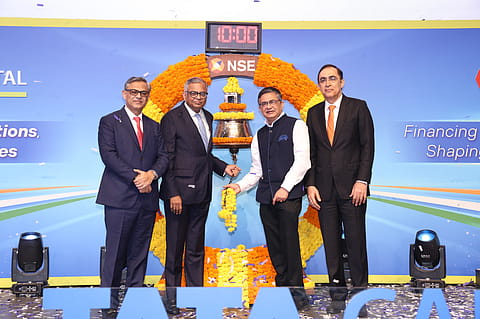From Paytm to Hyundai Motor India to Tata Capital: Big-ticket IPOs continue to struggle on D-Street
Tata Capital, despite being India’s largest IPO of 2025 and backed by the strong Tata Group brand, made a subdued debut on stock exchanges today.

Big-ticket initial public offerings (IPOs) continue to lose their sheen as Tata Capital’s tepid debut adds to a growing list of underperforming heavyweights. From Paytm’s lackluster listing to Hyundai Motor India’s underwhelming debut and now Tata Capital’s muted start, large IPOs are finding it hard to impress investors amid cautious sentiment and stretched valuations.
The latest entrant, Tata Capital, despite being India’s largest IPO of 2025 and backed by the strong Tata Group brand, made a rather subdued debut compared to market expectations.
Tata Capital’s ₹15,512-crore IPO made its stock market debut today, opening with a modest 1.23% gain, reflecting the ongoing caution surrounding mega issues. Shares of Tata Capital listed at ₹330 on the BSE and NSE, up 1.23% over the issue price of ₹326, valuing the company at around ₹1.4 lakh crore. Post listing, the NBFC’s stock rose as much as 2% to ₹332.80 apiece before settling at ₹331.75, up 1.76% from the issue price.
While the listing marks a notable entry for the Tata Group firm, the broader trend of weak performance among large-ticket IPOs—those above ₹10,000 crore—remains intact.
The shadow of underwhelming listings continues to loom over India’s biggest public offerings. The three largest IPOs in recent years have delivered subdued or negative listing-day returns. Hyundai Motor India’s ₹27,870-crore issue fell 7.16% on debut, while LIC of India’s ₹21,008-crore IPO opened 7.77% lower. Paytm’s ₹18,300-crore listing was the worst hit, plunging a staggering 27.44% on its first day of trade.
In contrast, state-owned Coal India, which raised ₹15,199 crore back in November 2010, bucked the trend—surging 47.17% on its debut.
Recommended Stories
Analysts view on Tata Capital
According to market analysts, Tata Capital’s listing was in line with its expectations, given the muted subscription demand and overall cautious investor sentiment. Despite valuations appeared reasonably when compared to its listed peers, the offer did not witness strong traction.
“Being Tata Capital’s strong brand equity under the Tata Group, its diversified business model, and robust presence across retail, corporate, and housing finance segments make it a compelling long-term play in India’s expanding financial services landscape. Tata Capital provides investors a credible and scalable proxy to participate in the broader NBFC growth cycle,” said Prashanth Tapse, Senior VP (Research), Mehta Equities.
Tapse has recommended that allotted investors should ‘Hold’ the stock for the long term, citing the company’s structural strengths and growth potential, while acknowledging short-term market risks. For non-allotted investors, he suggested adopting a wait-and-watch approach — monitoring the stock post-listing and considering accumulation on any meaningful dip.
“Despite being India’s largest IPO of 2025 and backed by the strong Tata Group brand, the listing was rather subdued compared to market expectations. The IPO had received decent investor participation, getting subscribed about 1.95 times overall, led by institutional demand,” said Shivani Nyati, Head of Wealth at Swastika Investmart Ltd.
(INR CR)
She said that the company’s fundamentals remain sound with steady growth and strong parentage, but valuations were seen as fair, leaving limited room for listing-day excitement.
“Going ahead, investors may consider booking partial profits near listing levels while holding some shares for the long term, as the company’s growth prospects remain attractive in India’s expanding financial services sector. A stop-loss around ₹300 is advisable to protect downside risk in the near term,” Nyati added.
JM Financial has initiated coverage on Tata Capital with an ‘ADD’ rating and a target price of ₹360, valuing the company at 2.9x FY27E P/B. The brokerage expects the company to deliver an AUM CAGR of 20% during FY25–27E, with largely stable operating expenses and a gradual decline in credit costs post FY26E. This is projected to result in a PAT CAGR of around 34% over FY25–27E, translating into average RoA/RoE of 1.9%/13.2% for FY26E/FY27E.
(DISCLAIMER: The views and opinions expressed by investment experts on fortuneindia.com are either their own or of their organisations, but not necessarily that of fortuneindia.com and its editorial team. Readers are advised to consult certified experts before taking investment decisions.)


